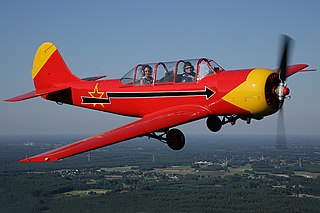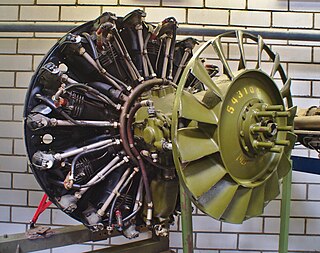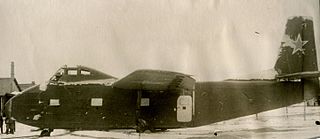
The Yakovlev Yak-42 is a 100/120-seat three-engined mid-range passenger jet developed in the mid 1970s to replace the technically obsolete Tupolev Tu-134. It was the first airliner produced in the Soviet Union to be powered by modern high-bypass turbofan engines.

The Yakovlev Yak-52 is a Soviet primary trainer aircraft which first flew in 1976. It was produced in Romania from 1977 to 1998 by Aerostar, as Iak-52, which gained manufacturing rights under agreement within the former COMECON socialist trade organisation. The Yak-52 was designed as an aerobatic trainer for students in the Soviet DOSAAF training organisation, which trained civilian sport pilots and military pilots. Currently the Yak-52 is used in the Fédération Aéronautique Internationale (FAI) World Aerobatic Yak 52 Competition, a popular powered aircraft one-design World Aerobatic Championship.

The Yakovlev Yak-11 is a trainer aircraft used by the Soviet Air Force and other Soviet-influenced air forces from 1947 until 1962.

The Sukhoi Su-26 is a single-seater aerobatic aircraft from the former Soviet Union, powered by a single radial reciprocating engine. The Su-26 has mid-mounted straight wings and fixed landing gear, the main gear mounted on a solid titanium arc.

The Yakovlev Yak-1 was a Soviet fighter aircraft of World War II. The Yak-1 was a single-seat monoplane with a composite structure and wooden wings; production began in early 1940.

The Yakovlev Yak-15 is a first-generation Soviet turbojet fighter developed by the Yakovlev design bureau (OKB) immediately after World War II. The main fuselage was that of Yakovlev Yak-3 piston-engine fighter modified to mount a reverse-engineered German Junkers Jumo 004 engine. The Yak-15 and the Swedish Saab 21R were the only two jets to be successfully converted from piston-power to enter production. 280 aircraft were built in 1947. Although nominally a fighter, it was mainly used to qualify piston-engine-experienced pilots to fly jets.

The Yakovlev Yak-54 is a 1990s Russian aerobatic and sports competition aircraft designed by the Yakovlev Aircraft Corporation.

The Yakovlev Yak-44 was a proposed twin-turboprop Airborne Early Warning (AEW) aircraft, resembling the United States Navy's E-2 Hawkeye, intended for use with the Soviet Navy's Ulyanovsk class supercarriers. Along with the aircraft carrier it would have flown from, the Yak-44 was cancelled after the demise of the Soviet Union. A full-scale mockup with foldable wings was built.

The Yakovlev Yak-18T is a four- or five-seat fully aerobatic utility aircraft developed by Yakovlev. Introduced to train Aeroflot pilots, it has gained some popularity as a sportplane both inside and outside the former USSR. It is powered by a 268-298 kW (360-400 hp) Vedeneyev M14P radial engine, and is designed for stresses of +6.48/-3.24 g.

The Yakovlev Yak-25 was a Soviet military aircraft, an early turbojet-powered fighter aircraft designed by the Yakovlev OKB. The designation was later reused for a different interceptor design. Tasked by the Council of Ministers in a directive issued on 11 March 1947, with producing a straight winged fighter similar to the earlier Yak-19, but powered by a Rolls-Royce Derwent V, OKB-115 swiftly produced the Yak-25, which blazed several trails as the first Soviet fighter with a fully pressurised cockpit, air conditioning, jettisonable canopy, and hydraulic airbrakes on the fuselage amongst other innovations.

The Vedeneyev M14P is a Russian nine-cylinder, four-stroke, air-cooled, petrol-powered radial engine. Producing 360 hp (268 kW), its design dates from the 1940s, and is itself a development of the Ivchenko AI-14 engine. The engine has been used extensively by the Yakovlev and Sukhoi Design Bureaus. The M14P is also used in some experimental aircraft and kit designs such as the Murphy Moose, Radial Rocket, Pitts Model 12, and others.

The Yakovlev Yak-30 was an experimental Soviet interceptor from the late 1940s. Derived from the Yak-25, from which it differed primarily in having wings sweptback 35° at quarter chord, the Yak-30 retained the fuselage, tail surfaces and undercarriage of the earlier fighter.

The Yakovlev Yak-14 was the largest assault glider ever to enter service with the Soviet Air Force. It was introduced in 1949, at a time when other air forces were abandoning the glider concept. In 1950 a Yak-14 became the first glider to fly over the North Pole.

The Yakovlev Yak-50 aerobatic aircraft is a single-seat all-metal low-wing monoplane with retractable main wheels and exposed tail wheel. The control surfaces are fabric-covered to save weight. The aircraft is not equipped with flaps.
The Yakovlev Yak-20 was an experimental piston-engined trainer developed in the Soviet Union in 1949. It did not go into production.
The Yakovlev Yak-53 was a single seat aerobatic trainer aircraft produced in the USSR during 1981/2. Only one prototype was produced.
The Yakovlev Yak-58 is a small, multi-role utility transport and business aircraft. The aircraft features a pusher engine and twin boom tail. It saw limited production in the late 1990s.
The Yakovlev Yak-5 was an experimental trainer aircraft designed by Yakovlev OKB in the Soviet Union, and first flown in 1944.
The Yakovlev AIR-6 was a Soviet light utility aircraft of the 1930s. It was a single-engined high-wing monoplane designed by Alexander Sergeyevich Yakovlev, with 128 being built.

The Technoavia SP-95 is a Russian aerobatic aircraft, a production version of the earlier SP-91 Slava. The design is similar to the Sukhoi Su-26 family as it was designed by the same designer. It is an aerobatic competition aircraft and can be changed from single-seat to two-seat configuration. The SP-95 is a metal construction low-wing cantilever monoplane with a conventional landing gear with a tail-wheel. It is powered by a Vedeneyev M14P radial piston engine.
















